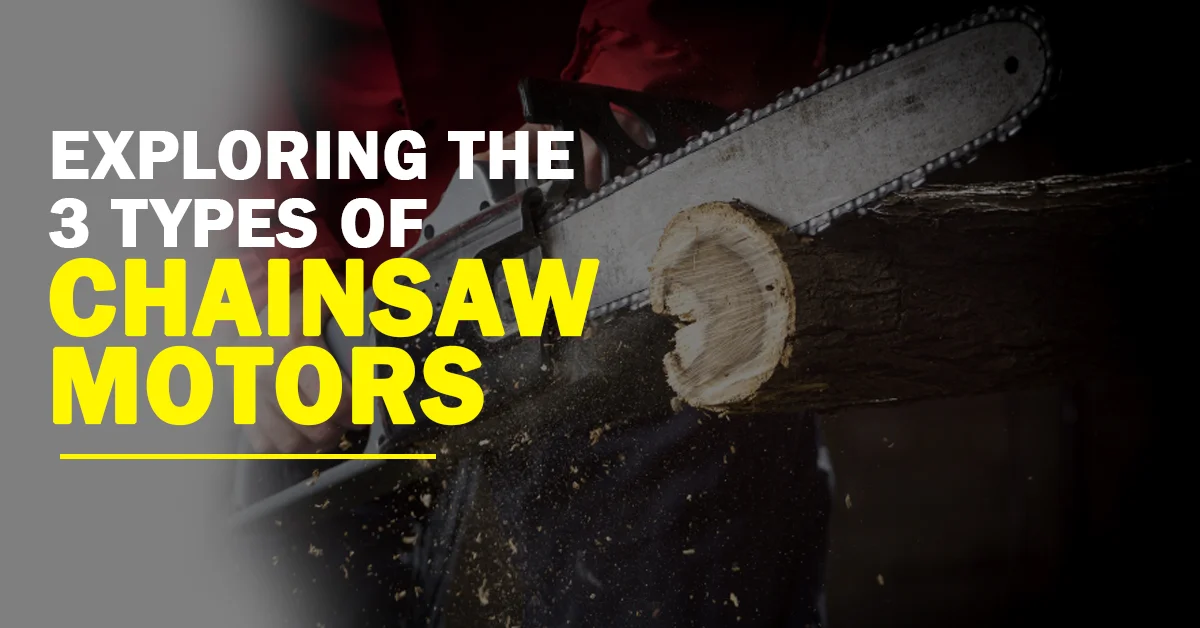Table of Contents
ToggleTypes Of Chainsaw Motors
Based on their source of power, chain saw motors may be divided into three main categories: gas-powered, electric, and battery-powered. Depending on the user’s particular needs and preferences, each kind offers pros and cons that may affect their decision.
To Know More About Construction Of Chainsaw Click Here
1. Chainsaws that run on gas:
The most popular kind of chain saws are gas-powered models, which are renowned for their performance and power. They operate their two-stroke engines, which have a high power-to-weight ratio, on a blend of gasoline and oil. These chainsaws are ideal for demanding jobs including logging, tree felling, and extensive trimming.
Advantages:
- Powerful output
- Appropriate for demanding duties
- They are portable since they don’t need a power outlet.
Disadvantages:
- Create exhaust emissions, which worsen air pollution.
- Need routine maintenance, such as replacing the spark plug and cleaning the air filter.
- In comparison to other varieties, it may be noisier and vibrate more.
- Chainsaws with electricity
To Know More About Gas Chainsaw Click Here
2. Electric chain saws
Require an electrical outlet to function since they are powered by electricity. They are a common option for homeowners and DIY enthusiasts who require a chain saw for sporadic usages, such as branch trimming and minor cutting jobs. They are often lighter and quieter than gas-powered chain saws.
Advantages:
- Quieter and less vibrating than chainsaws driven by gas
- Since there are no emissions, they are more ecologically beneficial.
- Reduced maintenance needs
Disadvantages:
- Restrictions imposed by the length of the power cord and the number of available outlets
- Typically, less powerful than chainsaws fuelled by gas
- Unsuitable for continuous usage or heavy-duty duties
To Know More About Electric Chainsaw Click Here
3. Chainsaws powered by batteries:
Rechargeable lithium-ion batteries are the power source for battery-powered chain saws, which makes them a cordless and portable choice. With the extra benefit of greater mobility, they provide advantages comparable to those of electric chain saws.
Advantages:
- Portable and cordless, providing more flexibility in movement
- Emission-free and friendly to the environment
- Quieter and less vibrating than chainsaws driven by gas
- Reduced maintenance needs
Disadvantages:
- Since battery life is constrained, they are less ideal for demanding jobs or extended use.
- Why Recharging batteries regularly might be time-consuming.
- Typically, less powerful than chainsaws fuelled by gas
Chainsaw Motors: Basic Parts
Chain saw motors are crucial parts of a chain saw because they supply the force required to move the cutting chain. A full and effective chain saw system is formed by the motor and other essential parts. Here, we’ll go through the main parts of a chain saw motor and what they do:
- A Motor or An Engine
- Chainsaws with a gasoline-and-oil combustion engine: These chainsaws operate on a two-stroke internal combustion engine. By transforming the chemical energy in the fuel into mechanical energy, the engine powers the cutting chain.
- Chainsaws that run on electricity from a power outlet are known as electric chainsaws. The cutting chain is turned by the electric motor, which transforms electrical energy into mechanical energy.
- Chainsaws that run on batteries: These chainsaws also include an electric motor, but instead of being plugged into an outlet, they are powered by rechargeable lithium-ion batteries.
- Carburetor (For Chainsaws Powered by Gas): Before entering the combustion chamber, the carburetor is in charge of combining the gasoline and air in the proper ratios. The ideal fuel-to-air ratio is essential for the most effective and efficient operation of the engine.
- Air Purifier: The air filter keeps dust and particles from harming the engine by cleaning the air that enters the carburetor. To preserve engine performance and extend its lifespan, the air filter has to be cleaned or replaced regularly.
- Chainsaws with Gas-Powered Ignition Systems: A spark plug and an ignition coil are components of the ignition system. The ignition coil supplies the high voltage required by the spark plug to generate the spark that ignites the fuel-air combination in the combustion chamber.
- System for Cooling To avoid overheating, a cooling system is required for chain saw motors while they are in use. The majority of chain saws employ air cooling, which involves blowing air over the engine’s cooling fins to dissipate heat.
- Exhaust System (For Chainsaws With Gas Engines): The burnt gases and unburned fuel are expelled from the combustion chamber through the exhaust system, which includes the muffler and exhaust port. The muffler also contributes to a reduction in engine noise.
- Clutch: The clutch, which links the engine to the chain saw’s cutting chain, is an essential part. It connects and releases the chain from the motor, which prevents the chain from spinning while the engine is running and ensures safe operation.
- Sprocket: A toothed wheel called a sprocket joins the clutch and chain. The chain may spin around the guide bar and carry out the cutting motion because it receives power from the engine through this device. Regardless of the kind, these are the essential parts of chain saw motors.
To Know More About the Construction Of Chainsaws Click Here
1. 2-Stroke Chainsaw Engines
Chainsaws frequently employ two-stroke engines because of their lightweight, compact construction, and superior weight-to-power ratio. Because they run on a two-stroke cycle, the engine completes the power (combustion) stroke and exhaust stroke in only one crankshaft rotation. The main characteristics and parts of a chainsaw’s two-stroke engine are as follows:
- Fuel Blend: A gasoline and oil fuel combination is necessary for two-stroke motors. Since two-stroke engines lack a distinct lubrication system like four-stroke engines do, the oil in the mixture lubricates the internal parts. Typically, the fuel-to-oil ratio is 50:1, however, this might change based on the manufacturer’s recommendations.
- Consumption and compression As the piston rises during the intake phase, the fuel-air combination enters the crankcase through the intake port. The fuel-air combination in the combustion chamber is compressed as the piston ascends farther.
- Combustion and Ignition: A spark from the spark plug ignites the compressed fuel-air combination in the combustion chamber when the piston reaches the top of its stroke. The power stroke is created when the piston is forced back down by the combustion.
- Scavenging and Exhaustion The exhaust port is made visible when the piston descends, allowing the consumed gases to escape. The residual exhaust gases are driven out of the combustion chamber at the same time that the fresh fuel-air combination in the crankcase is pumped into it, readying the engine for the subsequent combustion cycle.
Electric Chainsaw Motors
Chainsaws with electric motors operate more quietly and cleanly than those with gas engines. They are perfect for occasional usage for light-duty jobs like pruning branches and chopping small trees. The following are the main characteristics and elements of chainsaw electric motors:
- Energy Source: Electric chainsaws require an electrical outlet to function since they are powered by electricity. Typically, they require a 120V home socket, while certain powerful ones could need a 240V connection.
- Motor Kind: Generally speaking, brushless or brushed motors are used in electric chainsaws. Compared to brushless motors, brushed motors are more widespread and less expensive, but they are also less effective and last for a shorter time. Although they are more costly, brushless motors are more effective, produce less heat, and last longer.
- Power Scores The power output of electric chainsaw motors are rated by their size, which is commonly expressed in watts (W) or amps (A). Better cutting performance is typically associated with higher power ratings. Electric chainsaws are better suited for light-duty work since they typically have less power than gas-powered chainsaws.
- motor speed regulation Frequently, electric chainsaws have a speed control capability that enables users to alter the chain speed by the cutting task. This increases accuracy while lowering the possibility of kickback.
- Starting Process Electric chainsaws are simple to start; often, only a button press or trigger pull is needed. They are more user-friendly as a result compared to gas-powered chainsaws, which frequently demand many pulls of the starting cord.
- Noisy and jarring: Chainsaws with electric motors are much quieter and vibrate less than those with gas engines. This lessens noise pollution in residential areas and makes them more pleasant to use for extended durations.
- Maintenance: Compared to gas-powered engines, electric chainsaw motors require less maintenance. No fuel blending, carburetor tweaking, or spark plug change is required. For optimum performance and safety, users must still maintain the cutting chain, guide bar, and tensioning system.
Electric Chainsaws
Electric chainsaws that are corded need to be connected to an electrical outlet to function. They are appropriate for homeowners and DIY enthusiasts who require a chainsaw for light-duty jobs and infrequent use, such as branch trimming, firewood cutting, and tree pruning. The following are the main characteristics and benefits of corded chain saws:
- Permanent Power Supply: There is no need to worry about battery life or refilling because corded chainsaws get constant power from the outlet. The corded chainsaw may be continuously used for lengthy periods if you have access to an electrical outlet and an extension cable.
- Portable Design: Chain saws with cords are generally lighter than those using gas or batteries. As a result of their reduced weight, they are simpler to handle and maneuver, which lessens strain during prolonged usage.
- Power Scores: There are several different power ratings for corded chainsaws, which are often expressed in amps (A) or watts (W). Although corded chainsaws are often less powerful than gas-powered chainsaws, higher power ratings typically offer greater cutting ability.
- Low Vibration and Noise: When compared to gas-powered chainsaws, corded chainsaws make less noise and vibration, which improves user comfort and lessens noise pollution in residential areas.
- Friendly to the Environment: Compared to gas-powered chainsaws, corded chainsaws don’t emit any pollutants, making them a more ecologically friendly choice.
- Simple Beginning: A corded chain saw may usually be started by simply pressing a button or pulling a trigger. As with gas-powered chainsaws, no additional pulls of the ignition cord are required.
- Easy to Maintain: Compared to gas-powered chainsaws, corded chainsaws require less maintenance. No fuel blending, carburetor tweaking, or spark plug change is required. For optimum performance and safety, users must continue to maintain the cutting chain, guide bar, and tensioning system.
- Limitations: Corded chain saws’ primary drawbacks are their need for an electrical outlet and the length of the power cable. Users may need to utilize an extension cable to get to their work location and must make sure they have access to an electrical outlet. This drawback can limit mobility and render corded chainsaws unsuitable for challenging or far-flung outdoor operations.
Chainsaws With Batteries That Are Corded
Electric chainsaws that are corded need to be connected to an electrical outlet to function. They are appropriate for homeowners and DIY enthusiasts who require a chainsaw for light-duty jobs and infrequent use, such as branch trimming, firewood cutting, and tree pruning. The following are the main characteristics and benefits of corded chain saws:
- Permanent Power Supply: There is no need to worry about battery life or refilling because corded chainsaws get constant power from the outlet. The corded chainsaw may be continuously used for lengthy periods if you have access to an electrical outlet and an extension cable.
- Portable Design: Chain saws with cords are generally lighter than those using gas or batteries. As a result of their reduced weight, they are simpler to handle and maneuver, which lessens strain during prolonged usage.
- Power Scores: There are several different power ratings for corded chainsaws, which are often expressed in amps (A) or watts (W). Although corded chainsaws are often less powerful than gas-powered chainsaws, higher power ratings typically offer greater cutting ability.
- Low Vibration and Noise: When compared to gas-powered chainsaws, corded chainsaws make less noise and vibration, which improves user comfort and lessens noise pollution in residential areas.
- Friendly to the Environment: Compared to gas-powered chainsaws, corded chainsaws don’t emit any pollutants, making them a more ecologically friendly choice.
- Simple Beginning: A corded chain saw may usually be started by simply pressing a button or pulling a trigger. As with gas-powered chainsaws, no additional pulls of the ignition cord are required.
- Easy to Maintain: Compared to gas-powered chainsaws, corded chainsaws require less maintenance. No fuel blending, carburetor tweaking, or spark plug change is required. For optimum performance and safety, users must continue to maintain the cutting chain, guide bar, and tensioning system.
- Limitations: Corded chain saws’ primary drawbacks are their need for an electrical outlet and the length of the power cable. Users may need to utilize an extension cable to get to their work location and must make sure they have access to an electrical outlet. This drawback can limit mobility and render corded chainsaws unsuitable for challenging or far-flung outdoor operations.
Chainsaws With Batteries That Are Cordless
Rechargeable lithium-ion batteries are the power source for cordless or battery-powered chain saws, which offer a practical and portable alternative for cutting chores. They are perfect for homeowners and DIY enthusiasts who need a chainsaw for occasional, light-duty work. The following are the main characteristics and benefits of cordless chain saws:
- Portability: Due to their lack of a power cord, cordless chain saws provide outstanding portability and mobility. This enables customers to do business in off-the-grid or places without convenient access to energy.
- Portable Design: Similar to corded chainsaws, gas-powered chainsaws tend to be heavier than cordless models, which makes them more difficult to wield and maneuver when in operation.
- Power Scores:Different voltage levels for battery-powered chainsaws are available, including 18V, 40V, and 60V. Although higher voltage batteries often offer greater cutting performance and longer run durations, they might make the chainsaw heavier.
- Life of Battery: The battery’s ampere-hour (Ah) capacity determines how long a cordless chainsaw may be used. Longer run periods are provided by higher-capacity batteries, but they may also be heavier and need more time to charge.
- Charge Period: Battery capacity and charger output might affect how long it takes to charge a cordless chainsaw battery. Fast-charging features on some chargers allow for a considerable reduction in the amount of time needed to recharge a battery.
- Low Vibration and Noise: In comparison to gas-powered chainsaws, cordless chainsaws are more pleasant to handle and generate less noise pollution in residential areas.
- Friendly to the Environment: Chainsaws that run on batteries don’t emit any pollutants while in use, making them a more ecologically friendly option than those that use gas.
Carburetor (For Chain Saws Powered By Gas)
The fuel (a combination of gasoline and oil) and air before they enter the combustion chamber. The carburetor makes sure that the engine gets the right amount of fuel to air for effective functioning and smooth running. The primary components and duties of a carburetor in gas-powered chain saws are as A key component of gas-powered chain saws is the carburetor. It is in charge of properly combining follows:
- Vacuum Tube The carburetor’s throat, also known as the venturi tube, is a constricted area where the air is forced through at a higher velocity. Due to the drop in air pressure brought on by the increase in airspeed, a vacuum is created, which pulls the fuel from the fuel jets.
- The throttle valve The throttle valve, a butterfly valve, regulates how much air enters the carburetor. The operator may alter the throttle valve to change the engine’s speed and power.
- Chaffing valve Before the throttle valve comes the choke valve, another butterfly valve. It is used to briefly limit air intake during cold starts to provide a richer fuel-to-air mixture for simpler engine starting. The choke valve is opened to enable regular airflow once the engine has warmed up.
- Primary Jet A tiny opening called the main jet controls how much gasoline is injected into the engine at high speeds. When the throttle valve is fully open, it is in charge of maintaining the proper fuel-to-air ratio.
- Inert Jet: The amount of gasoline given to the engine at slow speeds or when it is idling is managed by the idle jet. When the throttle valve is closed, it guarantees smooth engine performance and avoids stalling.
- syringe valve The fuel flow from the main jet is adjusted by the needle valve, which is a movable part. It typically works in conjunction with the throttle valve and aids in preserving the ideal fuel-to-air ratio at all engine speeds.
- flotation chamber A float and a needle valve are both housed in the float chamber, where they cooperate to keep the fuel level constant. This guarantees that there is always enough gasoline available for the carburetor to combine with incoming air.
System Of Ignition For Gas Chain Saws
For the fuel-air combination in the combustion chamber of gas-powered chain saws to ignite, a spark must be produced by the ignition system. The chain saw is eventually propelled by the combustion process that is started by this spark. The following are the essential parts of a gas-powered chainsaw’s ignition system:
- Spiking Plug: An essential part of the ignition system is the spark plug. It has a ground electrode and a center electrode that are separated by an insulating ceramic. A spark created by a high-voltage electrical current flowing between the electrodes ignites the fuel-air combination in the combustion chamber.
- Coil of Ignition: The ignition coil is in charge of transforming the low voltage coming from the magneto or battery into the high voltage needed to ignite the spark plug. It has an iron core and two windings: a main winding and a secondary winding. A high voltage is produced in the secondary winding when the primary winding is activated and then quickly de-powered. This high voltage is then sent to the spark plug.
- CDI (Capacitor Discharge Ignition) or a magneto: A magneto or a CDI system is used by gas-powered chain saws to produce the electrical energy needed for ignition.
- Magneto: A magneto is a self-contained generator that generates electricity using permanent magnets and a revolving flywheel. Flywheel rotation produces a magnetic field that causes the magneto’s coils to conduct electricity. The ignition coil receives this electricity after which it is finally supplied to the spark plug.
- CDI: In a CDI system, a capacitor stores electrical energy before being quickly discharged to produce a high-voltage current. When necessary, the CDI unit discharges the capacitor to the ignition coil after charging it using the battery or an alternator. Compared to magneto systems, CDI systems often deliver sparks more quickly and consistently.
- Flywheel: In the ignition system, the flywheel, which is connected to the crankshaft, has two main functions. In the beginning, it offers the rotational energy required to move the magneto and produce electricity. The ignition system’s timing is triggered by a keyway or a collection of magnets in the second component, which guarantees that the spark is produced at the appropriate time throughout the engine’s cycle.
Guides For Chainsaw Purchase
- Power: When purchasing a chainsaw, power is one of the most crucial elements to take into account. A chainsaw’s power is often expressed in cubic centimeters (cc) or horsepower (HP). A smaller chainsaw with a lower power output might be adequate if you only want to use the chainsaw for modest tasks around your house. You will need a chainsaw with a larger power output if you intend to use it for heavy-duty cutting operations like down trees.
- Chainsaw bar length: A chainsaw’s bar length dictates how much wood it can cleave through. Chainsaws have bars that range in length from 12 inches to 24 inches. A shorter bar length should be adequate if you only want to use the chainsaw for minor chores. However, you’ll want a chainsaw with a longer bar length if you intend to take on larger trees or thicker branches.
- Chainsaws may be hefty, especially if you plan to use one for a long time. A lightweight chainsaw ought should be simpler to wield if you intend to use it for light chores. However, a bigger chainsaw could be required to deliver the required power if you intend to utilize the chainsaw for heavy-duty jobs.
- Chainsaws may be deadly, so before purchasing one, it’s critical to search for safety features. A chain brake, which stops the chain if the chainsaw kicks back, and an anti-vibration system, which lessens user-experienced vibration, are examples of popular safety measures.
- Price: Chainsaws come in a variety of price ranges, so before making a purchase, it’s crucial to decide how much you’re prepared to pay. Cheaper chainsaws could be adequate for simple tasks, but they might not be as durable as more costly versions. However, if you’re only going to utilize the chainsaw for minor tasks, pricey models might not be essential.
You should be able to choose a chainsaw that fits your demands and budget by taking these aspects into account.








Dear thesuperfox.com admin, Thanks for the well-researched and well-written post!